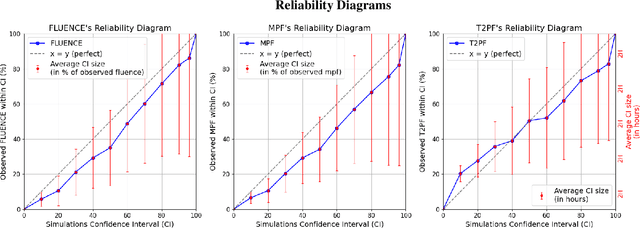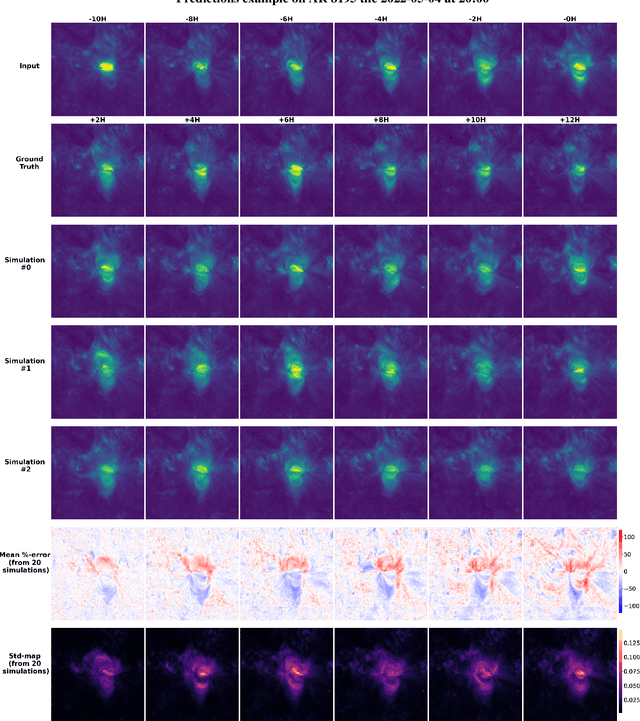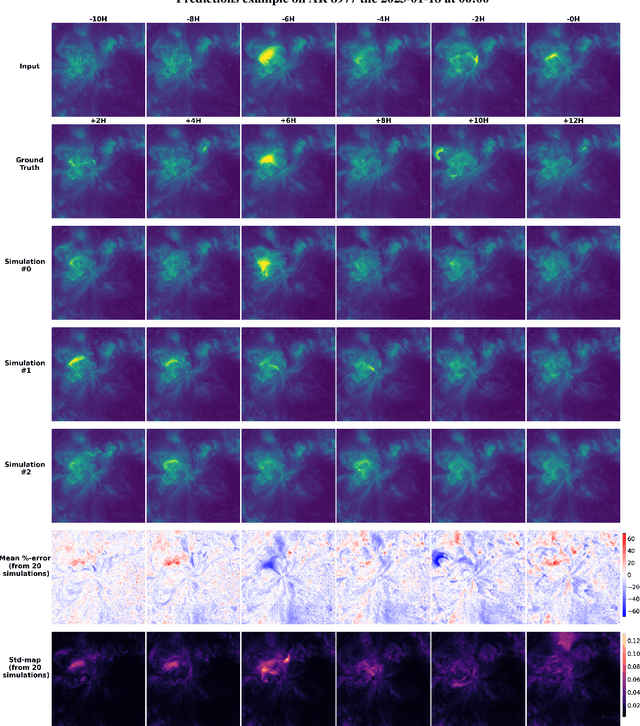Francesco Pio Ramunno
Enhancing Image Resolution of Solar Magnetograms: A Latent Diffusion Model Approach
Mar 31, 2025Abstract:The spatial properties of the solar magnetic field are crucial to decoding the physical processes in the solar interior and their interplanetary effects. However, observations from older instruments, such as the Michelson Doppler Imager (MDI), have limited spatial or temporal resolution, which hinders the ability to study small-scale solar features in detail. Super resolving these older datasets is essential for uniform analysis across different solar cycles, enabling better characterization of solar flares, active regions, and magnetic network dynamics. In this work, we introduce a novel diffusion model approach for Super-Resolution and we apply it to MDI magnetograms to match the higher-resolution capabilities of the Helioseismic and Magnetic Imager (HMI). By training a Latent Diffusion Model (LDM) with residuals on downscaled HMI data and fine-tuning it with paired MDI/HMI data, we can enhance the resolution of MDI observations from 2"/pixel to 0.5"/pixel. We evaluate the quality of the reconstructed images by means of classical metrics (e.g., PSNR, SSIM, FID and LPIPS) and we check if physical properties, such as the unsigned magnetic flux or the size of an active region, are preserved. We compare our model with different variations of LDM and Denoising Diffusion Probabilistic models (DDPMs), but also with two deterministic architectures already used in the past for performing the Super-Resolution task. Furthermore, we show with an analysis in the Fourier domain that the LDM with residuals can resolve features smaller than 2", and due to the probabilistic nature of the LDM, we can asses their reliability, in contrast with the deterministic models. Future studies aim to super-resolve the temporal scale of the solar MDI instrument so that we can also have a better overview of the dynamics of the old events.
Generative Simulations of The Solar Corona Evolution With Denoising Diffusion : Proof of Concept
Oct 28, 2024



Abstract:The solar magnetized corona is responsible for various manifestations with a space weather impact, such as flares, coronal mass ejections (CMEs) and, naturally, the solar wind. Modeling the corona's dynamics and evolution is therefore critical for improving our ability to predict space weather In this work, we demonstrate that generative deep learning methods, such as Denoising Diffusion Probabilistic Models (DDPM), can be successfully applied to simulate future evolutions of the corona as observed in Extreme Ultraviolet (EUV) wavelengths. Our model takes a 12-hour video of an Active Region (AR) as input and simulate the potential evolution of the AR over the subsequent 12 hours, with a time-resolution of two hours. We propose a light UNet backbone architecture adapted to our problem by adding 1D temporal convolutions after each classical 2D spatial ones, and spatio-temporal attention in the bottleneck part. The model not only produce visually realistic outputs but also captures the inherent stochasticity of the system's evolution. Notably, the simulations enable the generation of reliable confidence intervals for key predictive metrics such as the EUV peak flux and fluence of the ARs, paving the way for probabilistic and interpretable space weather forecasting. Future studies will focus on shorter forecasting horizons with increased spatial and temporal resolution, aiming at reducing the uncertainty of the simulations and providing practical applications for space weather forecasting. The code used for this study is available at the following link: https://github.com/gfrancisco20/video_diffusion
Magnetogram-to-Magnetogram: Generative Forecasting of Solar Evolution
Jul 16, 2024


Abstract:Investigating the solar magnetic field is crucial to understand the physical processes in the solar interior as well as their effects on the interplanetary environment. We introduce a novel method to predict the evolution of the solar line-of-sight (LoS) magnetogram using image-to-image translation with Denoising Diffusion Probabilistic Models (DDPMs). Our approach combines "computer science metrics" for image quality and "physics metrics" for physical accuracy to evaluate model performance. The results indicate that DDPMs are effective in maintaining the structural integrity, the dynamic range of solar magnetic fields, the magnetic flux and other physical features such as the size of the active regions, surpassing traditional persistence models, also in flaring situation. We aim to use deep learning not only for visualisation but as an integrative and interactive tool for telescopes, enhancing our understanding of unexpected physical events like solar flares. Future studies will aim to integrate more diverse solar data to refine the accuracy and applicability of our generative model.
 Add to Chrome
Add to Chrome Add to Firefox
Add to Firefox Add to Edge
Add to Edge